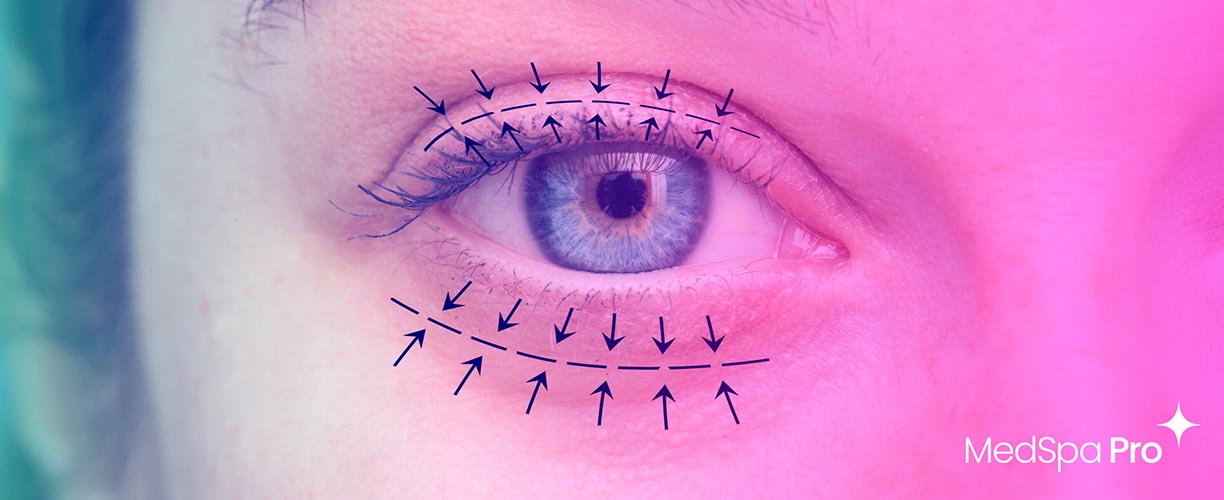
As the medical aesthetics industry evolves, patients are increasingly seeking comprehensive solutions that blend form and function. This shift isn’t just about smoother skin or fuller lips, it’s about restoring harmony to the entire face, including the delicate and complex periorbital region. Integrating oculoplastic procedures into a medical aesthetics or ophthalmology-based practice presents a timely opportunity to meet rising patient expectations while driving sustainable business growth.
Interest in oculoplastics is steadily growing as more ophthalmology and aesthetics practices recognize its unique value. But the benefits extend well beyond vision care. For medical aesthetics professionals, this specialty offers a bridge between clinical expertise and refined cosmetic outcomes.
The eye area is one of the earliest, and most noticeable, sites of aging. From under-eye hollowness to ptosis and excess eyelid skin, these features can convey fatigue or even visual obstruction long before other facial signs appear. As patients become more proactive in their aesthetic journeys, many are looking for subtle, surgical or non-surgical improvements that restore vitality while preserving their natural look.
By incorporating oculoplastics into your existing aesthetic practice, you give patients a trusted option for addressing these highly specific concerns without having to seek care elsewhere. This integrated approach enhances both patient satisfaction and clinical continuity, as you’re able to manage the entire patient experience, from consult to post-op recovery, within your ecosystem.
While the benefits are clear, the path to integration does require thoughtful planning. Oculoplastics is a microsurgical specialty that demands advanced training in eyelid anatomy, orbital structures, and tissue handling. Whether you’re expanding an ophthalmology clinic or a med spa, this may involve additional certifications, hands-on coursework, or the recruitment of a fellowship-trained oculoplastic surgeon.
Investment in surgical infrastructure - including minor procedure rooms, sterile instrumentation, and appropriate visualization technology - is often necessary. These upgrades can be significant but also pave the way for other advanced aesthetic services such as blepharoplasty, tear trough correction, or lacrimal drainage repair.
It’s important to recognize that oculoplastic procedures often span both cosmetic and functional indications. For example, upper eyelid surgery may be covered by insurance if it impairs a patient’s visual field. This opens the door to reimbursement pathways, but it also introduces billing complexities. Practices should be prepared to navigate CPT coding and preauthorization processes carefully, and should consider consulting with medical billing experts to avoid claim denials.
In today’s competitive aesthetic landscape, differentiation is essential. Adding oculoplastics allows your practice to offer a level of specialization that goes beyond routine injectables or skin treatments. For patients, this signals credibility, surgical precision, and the ability to deliver comprehensive facial rejuvenation.
Clinically, it allows for deeper synergy. For example, patients receiving blepharoplasty may benefit from periocular laser resurfacing or PRP microneedling to enhance recovery and skin texture. Similarly, combining surgical eyelid correction with lower-face biostimulatory fillers can produce more balanced, natural-looking results that reinforce your brand’s commitment to artistry and safety.
A critical factor in success lies in educating patients - not just about what oculoplastics can do, but why it requires expert care. While many patients are familiar with neuromodulators and fillers, eyelid surgery may feel more intimidating. Use your consultation time to clearly explain anatomy, surgical options, and expected recovery timelines. Visual aids and before-and-after photos can help set appropriate expectations and build confidence in your services.
Related Reading: Capturing Excellence: The Importance of High-Quality Imaging for Your Medical Aesthetics Before and After Photos
Moreover, position oculoplastics as a restorative treatment, not just an aesthetic one. Framing procedures in terms of functional improvement, such as reduced eyelid heaviness or improved vision, can expand their appeal and make them feel more medically justified.
Ultimately, integrating oculoplastics is more than a service line expansion, it’s a statement about the kind of care your practice offers. Patients are seeking providers who understand the nuances of facial aging, who can offer both surgical and non-surgical solutions, and who are capable of delivering outcomes that look natural, elegant, and personalized.
Whether a med spa aiming to attract more surgical clientele or a dermatologist looking to collaborate with an oculoplastic surgeon, now is the time to invest in specialized expertise that aligns with the future of facial aesthetics. As competition grows and patients become more informed, those who provide full-spectrum, evidence-based aesthetic care will set the standard - and thrive because of it.
Source: